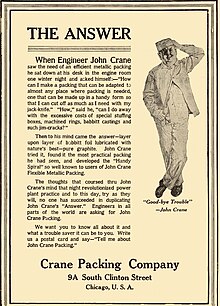
Polytetrafluoroethylene (PTFE) is a synthetic fluoropolymer of tetrafluoroethylene and is a PFAS that has numerous applications. The commonly known brand name of PTFE-based composition is Teflon by Chemours, a spin-off from DuPont, which originally discovered the compound in 1938.

In mechanical engineering, an end-face mechanical seal is a type of seal used in rotating equipment, such as pumps, mixers, blowers, and compressors. When a pump operates, the liquid could leak out of the pump between the rotating shaft and the stationary pump casing. Since the shaft rotates, preventing this leakage can be difficult. Earlier pump models used mechanical packing to seal the shaft. Since World War II, mechanical seals have replaced packing in many applications.

A gasket is a mechanical seal which fills the space between two or more mating surfaces, generally to prevent leakage from or into the joined objects while under compression. It is a deformable material that is used to create a static seal and maintain that seal under various operating conditions in a mechanical assembly.
Dresser Industries was a multinational corporation headquartered in Dallas, Texas, United States, which provided a wide range of technology, products, and services used for developing energy and natural resources. In 1998, Dresser merged with its main rival Halliburton. Halliburton sold many of former Dresser non "oil patch" divisions, retaining the M W Kellogg Engineering and Construction Company and the Dresser oil-patch products and services that complemented Halliburton's energy and natural resource businesses. In 2001 Halliburton sold five separate, but somewhat related former Dresser non "oil patch" divisions, to an investment banking firm. Those five operations later took the name "Dresser Inc." In October 2010, Dresser Inc., was acquired by General Electric. It is headquartered in Addison, Texas.

A bottle cap or bottle top is a closure for the top opening of a bottle. A cap is sometimes colorfully decorated with the logo of the brand of contents. Plastic caps are used for plastic bottles, while metal with plastic backing is used for glass; plastic caps are commonly made from polyethylene or polypropylene, while metal caps are usually either steel or aluminum. Plastic caps may have a pour spout. Flip-Top caps like Flapper closures provide controlled dispensing of dry products. Caps for plastic bottles are often made of a different type of plastic from the bottle.

An O-ring, also known as a packing or a toric joint, is a mechanical gasket in the shape of a torus; it is a loop of elastomer with a round cross-section, designed to be seated in a groove and compressed during assembly between two or more parts, forming a seal at the interface.

Crane Co. is an American industrial products company based in Stamford, Connecticut. Founded by Richard Teller Crane in 1855, it became one of the leading manufacturers of bathroom fixtures in the United States, until 1990, when that division was sold off. In 1960 it began the process of becoming a holding company with a diverse portfolio. Its business segments are Aerospace & Electronics, Engineered Materials, Payment and Merchandising Technology, Fluid Handling, and Controls. Industries served by these segments include chemical industries, commercial construction, food and beverage, general and commercial aviation, and power generation.
Terrence John McCann, commonly known as Terry McCann, was an American wrestler who won the Gold Medal in the bantamweight division of freestyle wrestling at the 1960 Summer Olympics in Rome, and later helped found the United States Wrestling Federation. He was born in Chicago, Illinois.
Victaulic is a developer and manufacturer of mechanical pipe joining systems, and the originator of the grooved pipe couplings joining system. The firm is a global company with 15 major manufacturing facilities, 28 branches, and over 3600 employees worldwide. Currently, its headquarters is located in Easton, Pennsylvania.

Garlock Sealing Technologies is a subsidiary of Enpro Company that produces sealing products. Garlock has a global presence, with 1,887 employees, at 14 facilities, in twelve countries.

Clarke Chapman is a British engineering firm based in Gateshead, which was formerly listed on the London Stock Exchange.

Vulcanized fibre or red fibre is a laminated plastic composed of only cellulose. The material is a tough, resilient, hornlike material that is lighter than aluminium, tougher than leather, and stiffer than most thermoplastics. The newer wood-laminating grade of vulcanized fibre is used to strengthen wood laminations used in skis, skateboards, support beams and as a sub-laminate under thin wood veneers.

UTEX Industries, Inc. is an American manufacturer of sealing products.

Asbestos is a naturally occurring fibrous silicate mineral. There are six types, all of which are composed of long and thin fibrous crystals, each fibre being composed of many microscopic "fibrils" that can be released into the atmosphere by abrasion and other processes. Inhalation of asbestos fibres can lead to various dangerous lung conditions, including mesothelioma, asbestosis, and lung cancer. As a result of these health effects, asbestos is considered a serious health and safety hazard.
Bristows is a full-service commercial, law firm, particularly known for its technology and intellectual property work.
The Queen's Award for Enterprise: International Trade (Export) (2006) was awarded on 21 April 2006, by Queen Elizabeth II.

Edwards Ltd is a British multinational vacuum pump and exhaust gas management systems manufacturer. Its headquarters are in Burgess Hill, UK, and has been part of the Atlas Copco Group since 2014. Edwards holds 1,700 patents, including for dry (oil-free) vacuum pumps, and produces equipment used for manufacturing semiconductors, scientific research, freeze drying and other industries. Its pumps remove contaminants at CERN's Large Hadron Collider. Manufacturing is predominantly handled by subsidiary businesses in the Czech Republic, South Korea, USA and China. Edwards' global research and development facilities remain in the UK.
The Duriron Company is an industrial component manufacturer of such products as automatic control valves, valves and actuators, pumps, sealing systems, filtration equipment, pipes and fittings. The company was incorporated in 1912 as the Duriron Casting Company in Dayton, Ohio by John R. Pitman, William E. Hall, and Pierce D. Schenck.
Catalytic distillation is a branch of reactive distillation which combines the processes of distillation and catalysis to selectively separate mixtures within solutions. Its main function is to maximize the yield of catalytic organic reactions, such as the refining of gasoline. The earliest case of catalytic distillation was thought to have dated back to 1966; however, the idea was officially patented in 1980 by Lawrence A. Smith, Jr. The process is currently used to purify gasoline, extract rubber, and form plastics.

In re Garlock Sealing Technologies, LLC is a court case heard in the United States District Court for the Western District of North Carolina which involves the entry into bankruptcy proceedings by Garlock Sealing Technologies, once a manufacturer of coated asbestos gaskets, as a result of potential liability from current and future settlements. The plaintiffs were over 4,000 asbestos victims suffering from mesothelioma, including many Navy veterans, as well as an unknown number of future mesothelioma victims. As noted by the court, mesothelioma "is always fatal, causing death essentially by suffocation within about eighteen months of diagnosis" and involves "a horrific death."














